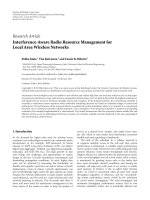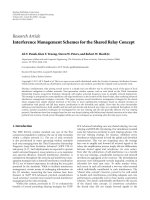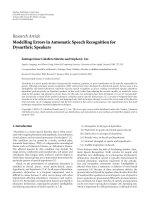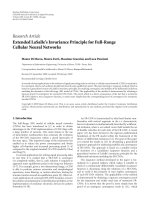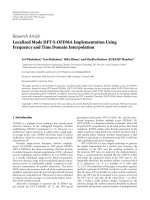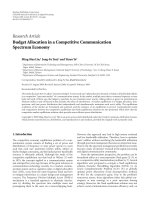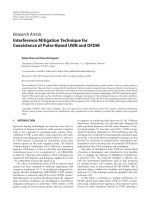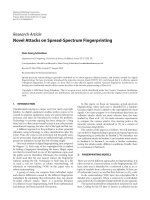Báo cáo hóa học: " Research Article Interference Excision in Spread Spectrum Communications Using Adaptive Positive Time-Frequency Analysis" pdf
Bạn đang xem bản rút gọn của tài liệu. Xem và tải ngay bản đầy đủ của tài liệu tại đây (839.82 KB, 9 trang )
Hindawi Publishing Corporation
EURASIP Journal on Wireless Communications and Networking
Volume 2007, Article ID 14916, 9 pages
doi:10.1155/2007/14916
Research Article
Interference Excision in Spread Spectrum Communications
Using Adaptive Positive Time-Frequency Analysis
Sridhar Krishnan and Serhat Erk
¨
uc¸
¨
uk
Department of Electrical and Computer Engineering, Ryerson University, Toronto, ON, Canada M5B 2 K3
Received 26 July 2006; Revised 10 February 2007; Accepted 24 May 2007
Recommended by Richard Kozick
This paper introduces a novel algorithm to excise single and multicomponent chirp-like interferences in direct sequence spread
spectrum (DSSS) communications. The excision algorithm consists of two stages: adaptive signal decomposition stage and di-
rectional e lement detection stage based on the Hough-Radon transform (HRT). Initially, the received spread spectrum signal is
decomposed into its time-frequency ( TF) functions using an adaptive signal decomposition algorithm, and the resulting TF func-
tions are mapped onto the TF plane. We then use a line detection algorithm based on the HRT that operates on the image of the
TF plane and detects energy varying directional elements that satisfy a parametric constraint. Interference is modeled by recon-
structing the corresponding TF functions detected by the HRT, and subtracted from the received signal. The proposed technique
has two main advantages: (i) it localizes the interferences on the TF plane with no cross-terms, thus facilitating simple filtering
techniques based on thresholding of the TF functions, and is an efficient way to excise the interference; (ii) it can be used for the
detection of any directional interferences that can be parameterized. Simulation results with synthetic models have shown suc-
cessful performance with linear and quadratic chirp interferences for single and multicomponent interference cases. The proposed
method excises the interference even under very low SNR conditions of
−10 dB, and the technique could be easily extended to any
interferences that could b e represented by a parametric equation in t he TF plane.
Copyright © 2007 S. Krishnan and S. Erk
¨
uc¸
¨
uk. This is an open access article distributed under the Creative Commons Attribution
License, which permits unrestricted use, distribution, and reproduction in any medium, provided the original work is properly
cited.
1. INTRODUCTION
In spread spectrum (SS) communications, the message sig-
nal is modulated and spread over a wider bandwidth with a
pseudonoise (PN) code also known at the receiver, and trans-
mitted over the channel. The increase of the bandwidth yields
a processing gain, defined as the ratio of the bandwidth of
the transmitted signal to the bandwidth of the message sig-
nal, and it provides a high degree of interference suppression.
However, there is a tradeoff between increasing the process-
ing gain and the available frequency spectrum. In the case of
a jammer with high power, the SS system may not be able
to suppress the interference. Therefore, excising the interfer-
ence prior to despreading the received signal is necessary to
increase the performance of the system.
Most interference suppression techniques are designed
to deal with narrowband interferences [1–5]. Among the
time-domain approaches for narrowband interference exci-
sion, the most notable methods include adaptive notch filter-
ing and decision-directed adaptive filtering techniques [6].
While SS systems can successfully reject narrowband inter-
ferences, their performance in rejecting wideband interfer-
ences is limited. In practical systems, it is not likely to trans-
mit high-power wideband jamming signals due to the power
limitations of the interference source. Additive white Gaus-
sian noise can be considered as the only realizable wide-
band interference, which is very challenging to predict and
excise. Therefore, substantial amount of research has been
conducted on wideband interferences with narrowband in-
stantaneous frequency elements such as FM signals. Most of
these methods focus on suppressing the interference using
TF distributions (TFDs) to localize the interference signals
[7]. However, commonly used TFDs suffer from a tradeoff
between the joint TF resolution and cross-term suppression.
In [8], Amin proposed a method based on the Wigner-Ville
distribution (WVD) of the signal, which represents the sig-
nal with precise TF localization; yet, the method is shown
to suffer from cross-terms in the presence of multicompo-
nent interferences. In the extension of this work [9], the au-
thors use the Wigner-Hough transform (WHT) to reduce the
2 EURASIP Journal on Wireless Communications and Networking
BPSK
SS
signal
Channel
Noise Interference
BPSK
demodulator
Interference excision
Interference
modeling
Detector
Message signal
estimate
++
−
Figure 1: Block diagram of a DSSS system.
crossterms [9]; however, the system is shown to be sensitive
to the sig nal model. Also, wavelet-based approaches provide
a time-scale representation and perform poorly for narrow-
band activities in the high frequency range.
In [10, 11], different window length STFTs are used to
localize the interference. In [12], the authors use a signal
decomposition algorithm consisting of a chirp-based dictio-
nary to represent linear chirp interferences on the TF plane.
The chirp interferences can be modeled with few coefficients
and the proposed method performs well w ith linear chirp in-
terferences. However, the generalization of the system to in-
clude quadratic, hyperbolic, or sinusoidal FM interferences
is not discussed. In [13], the instantaneous frequency of the
interference is recursively estimated using the discrete evolu-
tionary and Hough transforms, and the interference is sub-
tracted from the sig nal by using the singular value decompo-
sition of the de-chirped signal. In [14], the authors propose
an adaptive TF exciser that decides the domain of the exci-
sion by evaluating both the time and frequency properties.
This system performs well in the case of narrowband inter-
ferences. There are also the TF projection filtering techniques
as proposed in [15, 16].Acommoncharacteristicofmostof
the interference excision algorithms is the continuing pres-
ence of bit errors even after the interference is suppressed.
Earlier interference excision methods based on TFDs suf-
fer from a tradeoff between the TF resolution and the TFD
cross-terms [17–19]. They also perform the excision of lim-
ited type of interferences such as linear or sinusoidal interfer-
ences [9, 12]. Considering these two disadvantages, we pro-
pose a new excision method based on constructing a positive
TFD of the received SS signal using an adaptive signal decom-
position technique, the matching pursuit (MP) algorithm
[20]; followed by a line detection algorithm based on the
HRT. By decomposing a signal into its components, the inter-
action between components can be kept under control and
possibly eliminated. The decomposition will allow the con-
struction of a cross-term free TFD by combining the TFDs of
the individual components generated by the decomposition.
Also, by using Gaussian functions as bases for decomposi-
tion, we can achieve a high TF resolution, since the Gaus-
sian functions satisfy the equality in the uncertainty prin-
ciple and provide optimal TF resolution [7]. We construct
the TFD of the TF functions resulting from the MP, treat the
TFD as an image, and detect the interfering signals using the
HRT, which can detect any line satisfying a parametric equa-
tion. We then reconstruct a model of the interfering chirps
using the TF functions and excise the reconstructed interfer-
ence from the received signal.
The paper is organized as follows. In Section 2, the el-
ements of a DSSS system are introduced. In Section 3,an
adaptive signal decomposition technique based on MP and
the construction of positive TFDs are explained. Then the
HRT is introduced for the detection of chirps on the TF
plane. This section ends with outlining the steps of the ex-
cision algorithm consisting of MP and HRT. In Section 4, the
performance of the proposed system is evaluated in terms
of jammer-to-signal-power ratio, bit error rate, and average
chip error rate. The paper is concluded in Section 5.
2. DSSS SYSTEM
Let us consider a DSSS system as shown in Figure 1. In this
system, the tr ansmitter generates an SS signal which in turn
is transmitted over a communications channel as a binary
phase shift keying (BPSK) modulated signal. Additive chan-
nel noise as well as jamming signal act on the transmitted
signal. At the receiver, the noise and interference corrupted
signal is first demodulated. The “standard” SS receiver cor-
relates the baseband SS signal with the synchronized PN se-
quence, and the resulting signal is processed and input into
a threshold detector to estimate the t ransmitted binary data
sequence.
Let b
k
=±1 be the kth message symbol transmitted in a
DSSS system such that
w
k
= b
k
p
k
,(1)
where p
k
= [c
0
, , c
L−1
]
T
for {k = 1, 2, } is a PN sequence
with a chip length L, c
n
=±1 is the nth chip of the PN se-
quence, and w
k
is the SS signal. The received signal r
k
at the
output of the BPSK demodulator will consist of the SS sig-
nal w
k
, the additive white Gaussian noise term n
k
, and the
interference i
k
such that
r
k
= w
k
+ n
k
+ i
k
. (2)
We use the notation r to refer to the received signal sequence:
r
=
r
1
(0), , r
1
(L − 1), r
2
(0),
. (3)
Similarly, we use the notations w, n,andi to refer respectively
to the complete SS signal, noise, and interference sequences
before they are separated into L-element vectors in the form
w
k
, n
k
,andi
k
,fork = 1, 2,
S. Krishnan and S. Erk
¨
uc¸
¨
uk 3
10
0
10
−1
10
−2
10
−3
10
−4
BER
0 10203040
50 60
JSR (dB)
Figure 2:BERversusJSRresultsforaself-excisedSSsystem.
At the receiver, the received signal r is first synchronized
and correlated with the same spreading signal p. To estimate
b
k
, we use the PN sequence p
k
to despread r
k
, and integrate
the result to generate the test statistic Λ:
Λ
=
r
k
, p
k
=
p
T
k
r
k
=
L−1
n=0
p(n)r
k
(n).
(4)
Using the test statistic Λ, we estimate the message symbols as
b
k
=
⎧
⎨
⎩
+1, if Λ ≥ 0,
−1, if Λ < 0.
(5)
Let E
w
= w
T
w, E
n
= n
T
n,andE
i
= i
T
i. We define signal-
to-noise-power ratio (SNR) and jammer-to-signal-power ra-
tio (JSR) as
SNR
=
E
w
E
n
,
JSR
=
E
i
E
w
.
(6)
To illustrate the effects of increasing jammer power on
the message symbol detection, we simulated the channel out-
put with E
n
= 0, and a linear chirp as the jamming sig-
nal which sweeps the entire frequency spec trum of w.We
changed the JSR values from 0 to 60 dB in 5 dB steps. To mea-
sure the performance of the SS signal, we despread the re-
ceived signal r
= w + i, with the PN sequence p, integrate the
resulting sequence, and compare the result with a threshold
to estimate the transmitted message symbols. The bit-error-
rate (BER) results obtained from this simulation provide a
measure of the built-in interference suppression, that is, self-
excision capability of the SS system.
Figure 2 shows the BER values at different JSR levels. The
results presented in Figure 2 show that the SS system was able
to completely self-excise the interference for JSR < 10 dB, as
manifested with BER
= 0. The resistance of the system to in-
terference decreased with increasing JSR. For JSR > 40 dB, we
observed BER
≈ 50% indicating that the SS system cannot
suppress any part of the interference.
From these observations we conclude that preprocessing
of the SS signals is an essential step in expanding the operat-
ing range of SS systems in hig h-JSR environments. In partic-
ular, the preprocessing operations take the form of modeling
the interference and excising from the SS sign al before the
despreading and detection steps as shown in Figure 1.
3. INTERFERENCE EXCISION ALGORITHM
The interference excision algorithm is a two-step process
based on the matching pursuit (MP) algorithm and the
Hough-Radon transform (HRT) [21].
3.1. Matching pursuit algorithm
The MP algorithm [20] is an adaptive signal decomposition
technique that can decompose the signal into its TF func-
tions. In MP, the signal x(n)oflengthN is decomposed into
a linear combination of TF functions in
{g
γ
m
(n)},andcanbe
represented as
x( n)
=
∞
m=0
a
m
g
γ
m
(n), (7)
where
g
γ
m
(n) =
K
s
m
√
s
m
g
n − p
m
s
m
e
j((2πk
m
/N)n+φ
m
)
. (8)
The set
{a
m
} are the expansion coefficients, and {g(n)} is the
window function. K
s
m
normalizes g(n). The scale factor s
m
and the temporal placement parameter p
m
control the width
and the displacement of the window function, respectively.
The parameters k
m
and φ
m
represent the frequency and the
phase of the exponential func tion, respectively. k
m
allows the
search for different frequencies at each scale. The discrete dic-
tionary is limited with the set
{γ
m
}={(s
m
, p
m
,2πk
m
/N), 1 <
s
m
<N,0≤ p
m
<N,and0≤ k
m
<N}. One possible set of
functions to be used in the dictionary is the set of Gaussian
functions, where
g(λ)
= e
−λ
2
. (9)
The equality in the uncertainty principle holds for Gaussian
signals resulting in an optimal TF resolution [7]. Therefore,
a dic tionary consisting of Gaussian functions would result in
fine TF resolution.
In MP, the signal x(n) is projected onto the dictionary
{g
γ
m
(n)} of TF functions with all possible window sizes, fre-
quencies, and temporal placements. At each iteration, the
best-correlated function g
γ
m
is selected from the dictionary
and the remainder of the signal, which is called the residue,
is further decomposed using the same iteration procedure.
After M iterations, the signal x(n)canberepresentedas
x( n)
=
M−1
m=0
R
m
x, g
γ
m
g
γ
m
(n)+R
M
x, (10)
4 EURASIP Journal on Wireless Communications and Networking
where R
m
x represents the residue of the signal x(n)afterm
iterations with R
0
x = x, such that
a
m
=
R
m
x, g
γ
m
. (11)
The first term in (10) represents the first M Gaussian func-
tions best matching the signal (we wil l refer to the first term
as x
(n)) and the second term (referred to as x
(n)) repre-
sents the residue of the signal x(n). In order for the signal
to be fully decomposed, the iteration process continues un-
til all the energy in the residue signal is consumed. However,
for some applications such as denoising, the signal does not
need to be fully decomposed.
After the signal decomposition is achieved, the TFD
W(n, w) may be constructed by taking the WVD [20] of the
Gaussian functions represented in x
(n):
W(n, w)
=
M−1
m=0
a
m
2
W
g
γ
m
(n, w)
+
M−1
m=0
M
−1
l=0
l
=m
a
m
a
l
W
g
γ
m
,g
γ
l
(n, w),
(12)
where W
g
γ
m
(n, w) is the WVD of the Gaussian function
g
γ
m
(n)and
W
g
γ
m
,g
γ
l
(n, w) =
∞
k=−∞
g
γ
m
(n + k)g
∗
γ
l
(n − k)e
−jwk
. (13)
W
g
γ
m
(n, w) takes discrete time and frequency values since
{γ
m
}is a set of integers. The second term in (12) corresponds
to the cross-terms of the WVD and should be rejected in or-
der to obtain a cross-term free energy distribution of x
(n)in
the TF plane [20]. Therefore, the MP TFD which we denote
with the symbol W
(n, w)isgivenas
W
(n, w) =
M−1
m=0
a
m
2
W
g
γ
m
(n, w). (14)
The resulting MP TFD is a cross-term free distribution with
high TF resolution.
3.2. The Hough-Radon transform
The directional interferences can be energy varying. There-
fore, we require a directional element detector that can de-
tect time-varying energy values. The line detector that c an
satisfy our needs is a detector that uses the combination of
Hough and Radon transfor ms proposed in [22]. This detec-
torhasbeenmathematicallyproventobeanoptimaldetec-
tor as it provides the maximum likelihood identification of
a chirp signal [17]. The combined Hough and Radon trans-
form, the HRT, is an efficient tool to detect directional and
time-varying energy components in the TF plane. We first
discuss the Hough transform and the Radon transform, and
then continue to discuss the advantages of using the com-
bined HRT for TFDs.
The Hough transform
The Hough transform ( HT) is a pattern recognition method
for calculating the number of points that satisfy a parametric
constraint. It is used in image processing applications such as
object detection, texture analysis, char acter recognition, di-
rectional image analysis, and image compression. Although
HT is mainly applied to straight-line detection, it can also be
applied to other curves that can be described by equations
[23]. Let the parametric constraint be represented as
f (U, Θ)
= 0, (15)
where U
= (u
1
, u
2
, , u
K
) is a point in the space of possi-
ble features and Θ
= (θ
1
, θ
2
, , θ
L
) is a point in the space
of parameters. The parameter space is commonly referred to
as Hough space. The constraint may represent a curve, a line
or a surface depending on the interpretation of the feature
point. Each point Θ
0
in the parameter space represents a con-
straint that is a particular instance of a curve, line or a sur-
face. The constraint may be mapped into the Hough space by
evaluating
U : f
U, Θ
0
=
0
. (16)
The parameter values consistent with the existence of a given
feature point U
0
are curves that the particular point may lie
on, and are given by
Θ : f
U
0
, Θ
=
0
. (17)
Given a number of feature points that satisfy a constraint
specified by the parameter Θ
0
, the sets generated by (17)
for each feature will contain the point Θ
0
. Furthermore, (17)
may be viewed as a hypersurface in a continuous space of pa-
rameters. The curves of features satisfying a particular con-
straint will intersect at the common point Θ
0
in the parame-
ter space. The HT can be only applied to binary images.
The Radon transform
The Radon transform (RT) is a commonly used line detec-
tion technique in computer tomography [24]. The RT com-
putes the projections of different angles of an image (TFD) or
2D data distribution i
f
(u, v) measured as line integr a ls along
ray paths [24]:
R(ρ, θ)
=
∞
−∞
i
f
(u, v)δ
ρ − (u cos θ + v sin θ)
dudv,
(18)
where θ is the angle of the ray path of integration, ρ is the
distance of the ray path from the center of the image, and δ
is the Dirac delta function. Equation ( 18 ) represents integra-
tion of i
f
(u, v) along the line ρ = u cos θ+v sin θ as illustrated
in Figure 3. ρ denotes the distance of the perpendicular bisect
from the origin, and θ denotes the angle spanned by the line.
The RT adds up the pixel values in the given image along a
straight line in a particular direction and at a specific dis-
placement. The RT can be applied to both binary and gray-
level images.
S. Krishnan and S. Erk
¨
uc¸
¨
uk 5
ρ
v
θ
u
Figure 3: Line detection using RT.
Combined Hough and Radon transform
The Hough and the Radon transforms are individually not
adequate to detect directional elements with varying energy
levels. The underlying principle of the HT is that it is a pro-
cess for counting the number of pixels that satisfy paramet-
ric constraints in a binary image. This property may result in
misdetection of some energy varying components. The RT
may be seen as a special c ase of the HT for straight-line de-
tection. While the RT can be applied to gray-level images,
it does not encompass all possible variations of the HT. Con-
sidering the advantages and disadvantages of each transform,
we use the combined HRT as proposed in [22]. Using the
combined HRT, we can detect the pixels that form a paramet-
ric constraint in a g ray-level image. These constraints can be
straight lines or curves in the image of the TF plane. We will
consider the TF plane as an image matrix which will replace
the 2D data distribution i
f
(u, v) in the formulation of the
RTgivenin(18). Let I be a K
× N image matrix representa-
tion of the TF plane, where its elements I(k, n) represent the
gray-level intensities. K is the number of rows correspond-
ing to the number of frequency slots, and N is the number of
columns that correspond to the number of time slots in the
TFD. K and N vary according to the resolution of the TFD,
the time duration, and the signal bandwidth.
The formulation of the HRT for discrete data sets is given
as follows:
R(Θ)
=
(k,n)∈A(Θ)
I(k, n), (19)
where
A(Θ) =
(k, n):(k, n) ∈ [1, K]
× [1, N]: f (k, n, Θ) = 0
,
(20)
and
f (k, n, Θ)
= 0 (21)
is the parametric constraint equation in the image plane.
In general, the implementation of the HRT would require
thatwefirstdetermineasufficiently fine search grid Θ
s
,for
r
MP
r
w
MP
TFD
HRT
R (Θ)
W
Θ
∗
Interference
estimation
i
+
−
Figure 4: Interference excision.
the parameter space, which will allow us to differentiate all
parametric curves of the form given in (21) within the reso-
lution limitations of the image matr ix. This search grid func-
tions as a quantized parameter space.
In the implementation of the HRT, the transform value
R(Θ
0
)atsomeΘ
0
∈ Θ
s
contains the total energy in the pix-
els that satisfy the parametric constraint equation. Therefore,
we can devise an HRT-based system to detect directional el-
ements defined by parametric equations: the peak values of
the HRT will yield the most likely parameter values.
3.3. The excision algorithm
Figure 4 provides an overview of the proposed algorithm. Af-
ter the interference excision, the “interference suppressed” SS
signal is processed as before by first correlating with the syn-
chronized PN sequence, integrating the resulting sequence,
and estimating the transmitted data symbols using a thresh-
old detector.
For the interference excision algorithm, we assume that
the information on the number and type of interference sig-
nals is available. In particular, we assume that the interfer-
ence signals are linear or quadratic FM signals which can be
present simultaneously. Let τ
∈{linear,quadratic} be the
type of interference, and let M
τ
be the number of interfer-
ence signals of type τ.
Step 1. The received sig nal r is modeled as a linear combina-
tion of Gaussian functions using the MP algorithm given in
Section 3.1.Letr
be the model generated by MP algorithm
as in
r
(n) =
M−1
m=0
a
m
g
γ
m
(n), (22)
where g
γ
m
(n) are the Gaussian TF functions given in (8). The
model order M is determined as the smallest positive integer
which will make r
={r
(0), r
(1), } satisfy the condition
N−1
n=0
r(n) − r
(n)
2
≤ N, (23)
where N is the length of r.
Step 2. Formulate the parameter set G using the parameters
of the Gaussian TF functions g
γ
m
, such that
G
=
k
m
, p
m
, m = 0, , M −1
, (24)
6 EURASIP Journal on Wireless Communications and Networking
where k
m
and p
m
are the frequency and temporal placement
parameters of the TF function g
γ
m
,respectively.
Step 3. Compute the cross-term free TFD of r
using the
WVD:
W
(n, w) =
M−1
m=0
a
m
2
W
g
γ
m
(n, w), (25)
where W
g
γ
m
(n, w) is the WVD of the Gaussian function
g
γ
m
(n).
Step 4. Let I(k, n) be the K
× N image matrix representa-
tion of W
(n, w). For each interference type τ known to be
present in the received signal, determine the corresponding
quantized parameter space Θ
τ
and evaluate the HRT given
in Section 3.2 and R(Θ
τ
) using (19)–(21).
Step 5. For each interference type τ known to be present
in the received signal, determine the M
τ
parameters
{Θ
(1)
τ
, , Θ
(M
τ
)
τ
} from the quantized parameter space Θ
τ
corresponding to the first M
τ
maxima of R(Θ
τ
). Let
Θ
∗
τ
=
Θ
(1)
τ
, , Θ
(M
τ
)
τ
. (26)
Step 6. For each interference type τ known to be present in
the received signal and for each Θ
(m)
τ
∈ Θ
∗
τ
, determine the
index set L
(m)
τ
⊂{0, , M −1} defined as
L
(m)
τ
=
l : l ∈{0, , M − 1},
k
l
, p
l
∈
G, f
τ
k
l
, p
l
, Θ
(m)
τ
± ΔΘ
=
0
,
(27)
where f
τ
(k, p, Θ) = 0 is the parametric constraint describing
the interference of type τ and ΔΘ is the empirically deter-
mined confidence measure.
Step 7. For each interference type τ known to be present in
the received signal and for each m
∈{1, , M
τ
},construct
the corresponding interference model as
ı
(m)
τ
(n) =
l∈L
(m)
τ
a
l
g
γ
l
(n). (28)
Step 8 . Determine the interference excised SS signal by sub-
tracting the interference models generated in Step 7 from the
received signal:
w(n) = r(n) −
τ
M
τ
m=1
ı
(m)
τ
(n). (29)
Before presenting the simulation results, the computa-
tional complexity of the proposed technique is briefly dis-
cussed. The search algorithm above uses both MP and HRT.
Therefore, there are two factors that affect the computation
time. For MP, the computation time will depend on how well
the dictionary elements (Gaussian functions) given in (8)can
match the interference signal. A conclusive comment on the
effect of interference types (e.g., linear versus quadratic) on
the computational complexity cannot be made as the rep-
resentation of different parametric equations w ith Gaussian
functions being not studied and compared in the literature.
In [12], the authors used a chirp-based dictionary to reduce
the computation time of linear chirps; however, this dictio-
nary would fail to model other parametric equations. Also, it
should be noted that the computation time will linearly in-
crease with the number of interference signals. For HRT, the
computation complexity of the search algorithm is O(N
2
).
To decrease the computational complexity of the HRT tech-
nique, variants of HRT such as the randomized Hough trans-
form [25] can be considered. Also, a further study can be
conducted on the optimization of HRT search algorithm,
which is beyond the scope of this paper. In the following, the
proposed excision algorithm is evaluated.
4. SIMULATION RESULTS AND DISCUSSION
The simulation results presented in this section are based on
a DSSS system with L
= 128 chips per message symbol b
k
.
The transmitted message contained 100 message symbols.
We assumed that the channel was nondispersive, and the re-
ceived signal and the PN sequence were synchronized.
4.1. Performance measures
Bit error rate (BER). For the DSSS model used in this study,
we process the received signal using the interference
excision algorithm, and estimate the transmitted mes-
sage symbols using the detector structure presented
in Section 2. A comparison of the estimated message
symbols
{
b
k
} with {b
k
}, and expressing the number of
erroneous estimates as a percentage of the total num-
ber of message symbols yields the bit error rate.
Chip error rate. We define the chip error as
sign
p
k
(n) w
k
(n)
= sign
p
k
(n)w
k
(n)
, (30)
for n
∈{0, , L − 1} and k ∈{1,2, }.
4.2. BER performance
To measure the performance of the DSSS system using the
new interference excision algorithm developed in this paper,
we evaluated the BER results for the following three interfer-
ence scenarios, where we assumed the presence of
(i) a single-component linear chirp,
(ii) a s ingle-component quadratic chirp,
(iii) a multicomponent interference with linear and quad-
ratic chirps.
The interferences were measured with JSR values in the range
of0to50dBat10dBsteps.WeassumedtheSNRtobe
10 dB in each case. We suppressed the interference before
despreading, using the proposed interference excision algo-
rithm. We observed zero bit errors in all cases after the exc ision
of single-component and multicomponent inte rferences.Were-
peated the same process for different SNR values in the range
of
−10 dB to 10 dB, and also recorded zero bit errors.
One of the main reasons for having zero BER in these
simulation runs is the accurate TF representation of inter-
ferences, and the successful detection by the HRT. A similar
S. Krishnan and S. Erk
¨
uc¸
¨
uk 7
0.5
0.4
0.3
0.2
0.1
0
Normalized frequency
0 2500 5000 7500 10000 12500
Time samples
Figure 5: MP TFD of a multicomponent interference consisting of
linear and quadratic chirps.
observation was made by Bultan et al. in [12], where they
represent linear interferences with good TF localization us-
ing adaptive chirplet decomposition. However, they do not
report any results on the excision of quadratic and/or mul-
ticomponent interferences. Other TFD-based methods re-
ported bit errors for similar excision conditions [8, 9, 11].
As an example we plot in Figure 5 the MP TFD
1
ofamul-
ticomponent interference consisting of linear and quadratic
chirps at JSR
= 40 dB.
4.3. Chip error rate performance
We evaluated the DSSS system by calculating the percentage
of chips received in error at various SNR values. Figures 6 and
7 show the simulation results for calculating the chip error
rates for the JSR values 40 dB and 5 dB, respectively.
Figure 6 shows the percentage of chips in error before
and after the excision of single and multicomponent inter-
ferences. The JSR value of 40 dB is used because at this JSR
level with no interference excision, the system BER is approx-
imately 50 percent indicating that the system cannot suppress
any part of the interference. It is observed that the excision of
a single interference results in less chip error rate than the
excision of a multicomponent interference. This is a result of
the excision of a multicomponent interference introducing
more noise than the excision of a single-component interfer-
ence at the same power level. When the estimates of the inter-
ferences are excised from the SS signal, part of the SS signal
in the vicinity of the interference localization are also sup-
pressed. Therefore, multicomponent interferences are likely
to introduce more residual noise.
1
Although the SS signal is also partly decomposed and represented on the
TF plane, its lower energy compared to interferences makes it invisible on
the MP TFD obtained by the WVD.
JSR = 40 dB, L = 128
0.5
0.4
0.3
0.2
0.1
0
Chip error rate
−10 −8 −6 −4 −20246810
SNR (dB)
No interference
No excision (single/multiple interference)
Single interference excised
Multiple interference excised
Figure 6: Chip error rate versus SNR for JSR = 40 dB.
JSR = 5dB,L = 128
0.5
0.4
0.3
0.2
0.1
0
Chip error rate
−10 −8 −6 −4 −20246810
SNR (dB)
No interference
No excision (single interference)
No excision (multiple interference)
Single interference excised
Multiple interference excised
Figure 7: Chip error rate versus SNR for JSR = 5dB.
Figure 7 shows the results for the same experimental
setup at JSR
= 5 dB. JSR v alue of 5 dB is used since the sys-
tem can suppress the interference partly without interference
excision prior to despreading. In systems proposed by other
researchers [8], the excision of the low-power interference
degrades the performance of the system. In the case of the
new interference excision algorithm we developed in this pa-
per, the proposed system has substantially improved the chip
8 EURASIP Journal on Wireless Communications and Networking
0.5
0.4
0.3
0.2
0.1
0
Normalized frequency
0 12500
Time samples
(a)
0.5
0.4
0.3
0.2
0.1
0
0 12500
Time samples
(b)
0.5
0.4
0.3
0.2
0.1
0
0 12500
Time samples
(c)
Figure 8: TFDs of (a) SS signal with a linear interference at JSR = 5 dB, (b) estimate of the interference, (c) interference excised SS signal.
error rate. The results obtained show that the excision of the
single interference results in less chip error rate, consistent
with the results plotted in Figure 6.
For illustration purposes, in Figure 8 we provide the
TFDs of the SS signal with a single interference (JSR
= 5dB)
(left plot), the interference detected by HRT (middle plot),
the interference excised SS signal (right plot).
The simulation results show that the proposed technique
can be successfully used for excision of single-component
and multicomponent chirp-like interferences using adaptive
TFDs and the HRT. The new algorithm suppresses the in-
terferences, while introducing an acceptable magnitude of
noise, which can be overcome by the spreading gain. This
results in zero bits in error after interference excision.
5. CONCLUSIONS
In this paper, we proposed a new interference excision al-
gorithm and evaluated its performance in terms of the BER
and chip error rates. The most striking observation result-
ing from the simulation studies is that there were no bit errors
after the excision of single and multicomponent interferences
at all JSR levels tested, that is, JSR
≤ 50 dB. Under similar
test conditions, the algorithms developed in earlier studies
reported bit errors with the notable exception of [12].
This highly desirable characteristic is the result of the fol-
lowing three factors.
(1) T he model of the interference uses Gaussian functions,
which provide optimal TF resolution within the limits
of the uncertainty principle.
(2) The MP TFD uses WVD, which also localizes the com-
ponents well and provides a high TF resolution. The
modeling of the interferences as a linear combination
of basis functions eliminated the cross-terms in the
construction of the TFD for multicomponent interfer-
ences. Lack of cross-terms prevents undesired peaks in
the HRT space, which may lead to incorrect parameter
estimates.
(3) The HRT algorithm acts as an adaptive threshold-
ing mechanism successfully determining the functions
that model the interference.
Another important conclusion of this paper is that the
proposed algorithm can excise any interference that can be
modeled using a paramet ric equation. This is a consequence
of the HRT being able to detect any directional element de-
fined by par a metric constraints. Other algorithms focus only
on linear, or sinusoidal interferences, and break down, if
there are nonlinear and/or multicomponent interferences.
S. Krishnan and S. Erk
¨
uc¸
¨
uk 9
REFERENCES
[1] W. Yang and G. Bi, “Adaptive wavelet packet transform-based
narrowband interference canceller in DSSS systems,” Electron-
ics Letters, vol. 33, no. 14, pp. 1189–1190, 1997.
[2] A. Ranheim, “Narrowband interference rejection in direct-
sequence spread-spectrum system using time-frequency de-
composition,” IEE Proceedings: Communications, vol. 142,
no. 6, pp. 393–400, 1995.
[3] H. V. Poor and X. Wang, “Adaptive suppression of narrowband
digital interferers from spread spectrum signals,” in Proceed-
ings of IEEE International Conference on Acoustics, Speech, and
Signal Processing (ICASSP ’96), vol. 2, pp. 1061–1064, Atlanta,
Ga, USA, May 1996.
[4] L. Liu and H. Ge, “Time-varying AR modeling and subspace
projection for FM jammer suppression in DS/SS-CDMA sys-
tems,” in Proceedings of the 37th Asilomar Conference on Sig-
nals, Systems and Computers (ACSSC ’03), vol. 1, pp. 623–627,
Pacific Grove, Calif, USA, November 2003.
[5] K. D. Rao, M. N. S. Swamy, and E. I. Plotkin, “A nonlin-
ear adaptive filter for narrowband interference mitigation in
spread spectrum systems,” Signal Processing,vol.85,no.3,pp.
625–635, 2005.
[6] J. D. Laster and J. H. Reed, “Interference rejection in digital
wireless communications,” IEEE Signal Processing Magazine,
vol. 14, no. 3, pp. 37–62, 1997.
[7] L. Cohen, “Time-frequency distributions-a review,” Proceed-
ings of the IEEE, vol. 77, no. 7, pp. 941–981, 1989.
[8] M. G. Amin, “Interference mitigation in spread spect rum
communication systems using time-frequency distributions,”
IEEE Transactions on Signal Processing, vol. 45, no. 1, pp. 90–
101, 1997.
[9] S. Barbarossa and A. Scaglione, “Adaptive time-varying can-
cellation of wideband interferences in spread-spectrum com-
munications based on time-frequency distributions,” IEEE
Transactions on Sig nal Processing, vol. 47, no. 4, pp. 957–965,
1999.
[10] B. S. Krongold, M. L. Kramer, K. Ramchandran, and D. L.
Jones, “Spread spectrum interference suppression using adap-
tive time-frequency tilings,” in Proceedings of IEEE Interna-
tional Conference on Acoustics, Speech, and Sig nal Processing
(ICASSP ’97), vol. 3, pp. 1881–1884, Munich, Germany, April
1997.
[11] X. Ouyang and M. G. Amin, “Short-time Fourier transform
receiver for nonstationary interference excision in direct se-
quence spread spectrum communications,” IEEE Transactions
on Signal Processing, vol. 49, no. 4, pp. 851–863, 2001.
[12] A. Bultan and A. N. Akansu, “A novel time-frequency ex-
ciser in spread spectrum communications for chirp-like in-
terference,” in Proceedings of IEEE International Conference on
Acoustics, Speech, and Signal Processing (ICASSP ’98) , vol. 6,
pp. 3265–3268, Seattle, Wash, USA, May 1998.
[13] R. Suleesathira and L. F. Chaparro, “Jammer excision in spread
spectrum using discrete evolutionar y-Hough transform and
singular value decomposition,” in Proceedings of the 10th IEEE
Signal Processing Workshop on Statistical Signal and Array Pro-
cessing (SSAP ’00), pp. 519–523, Pennsylvania, Pa, USA, Au-
gust 2000.
[14] M. V. Tazebay and A. N. Akansu, “Adaptive subband tr ans-
forms in time-frequency excisers for DSSS communications
systems,” IEEE Transactions on Signal Processing, vol. 43,
no. 11, pp. 2776–2782, 1995.
[15] G. Matz and F. Hlawatsch, “Time-frequency projection filters:
online implementation, subspace tracking, and application
to interference excision,” in Proceedings of IEEE Interna-
tional Conference on Acoustics, Speech, and Sig nal Processing
(ICASSP ’02), vol. 2, pp. 1213–1216, Orlando, Fla, USA, May
2002.
[16] M. G. Amin and G. R. Mandapati, “Nonstationary interfer-
ence excision in spread spect rum communications using pro-
jection filtering methods,” in Proceedings of the 32nd Asilomar
Conference on Signals, Systems and Computers, vol. 1, pp. 827–
831, Pacific Grove, Calif, USA, November 1998.
[17] S. Krishnan, Adaptive signal processing techniques for analysis
of knee joint vibroarthrographic signals, Ph.D. thesis, University
of Calgary, Alberta, Canada, June 1999.
[18] L. Cohen and T. Posch, “Positive time-frequency distribution
functions,”
IEEE Transactions on Acoustics, Speech, and Signal
Processing, vol. 33, no. 1, pp. 31–38, 1985.
[19] P. J. Loughlin, J. W. Pitton, and L. E. Atlas, “Construction of
positive time-frequency distributions,” IEEE Transactions on
Signal Processing, vol. 42, no. 10, pp. 2697–2705, 1994.
[20] S. G. Mallat and Z. Zhang, “Matching pursuits with time-
frequency dictionaries,” IEEE Transactions on Signal Process-
ing, vol. 41, no. 12, pp. 3397–3415, 1993.
[21] S. Erkucuk and S. Krishnan, “Time-frequency filtering of in-
terferences in spread spectrum communications,” in Proceed-
ings of the 7th International Symposium on Signal Processing
and Its Applications (ISSPA ’03), vol. 2, pp. 323–326, Paris,
France, July 2003.
[22] R. M. Rangayyan and S. Krishnan, “Feature identification in
the time-frequency plane by using the Hough-Radon trans-
form,” Pattern Recognition, vol. 34, no. 6, pp. 1147–1158, 2001.
[23] R. O. Duda and P. E. Hart, “Use of the Hough transformation
to detect lines and curves in pictures,” Communications of the
ACM, vol. 15, no. 1, pp. 11–15, 1972.
[24] G. T. Herman, Image Reconstruction from Projections. The Fun-
damentals of Computerized Tomography, Academic Press, New
York, NY, USA, 1980.
[25] L.Xu,E.Oja,andP.Kultanen,“Anewcurvedetectionmethod:
randomized Hough transform (RHT),” Pattern Recognition
Letters, vol. 11, no. 5, pp. 331–338, 1990.
